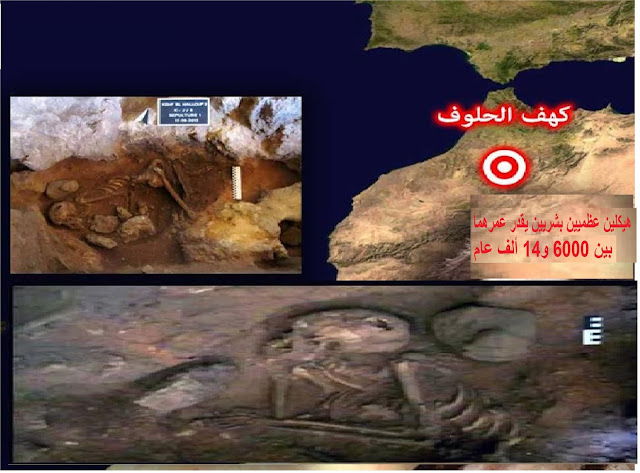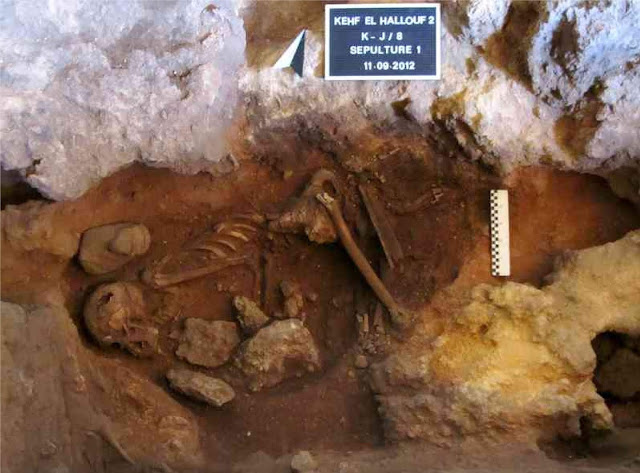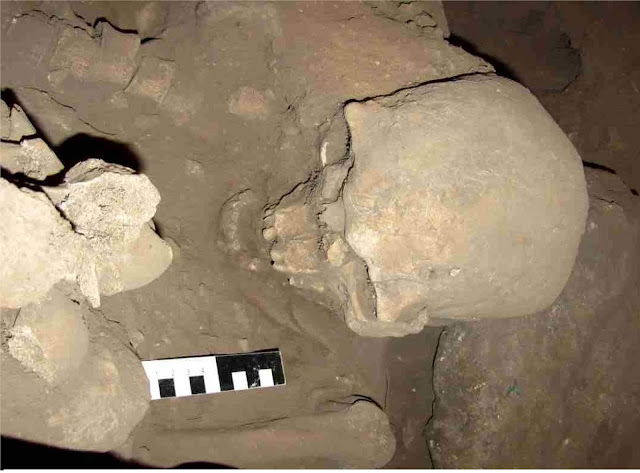The Great Amazigh Migration to the African Coast in the Holocene and Neolithic Era

B yen between 30 thousand to 9000 thousand years BC)
This important anthropological discovery was confirmed after the discovery of the remains of a primitive man at the site of Gobero in Niger, representing the oldest habitation in the green African desert during the Holocene era (between 30 thousand to 9000 thousand years BC) and after it in the Neolithic era.
The researchers issued a study related to this discovery under the title
Lake cemeteries in the Sahara: 5000 years of Holocene and environmental changes
https://journals.plos.org/plosone/article?id=10.1371%2Fjournal.pone.0002995&fbclid=IwAR2zuEVv6se2yyLJP_c9qs88P6hrHvgvkVXkNrIMPokk7ezqqpiyMb9BPzM
Where the study showed that residents of the Great Maghreb (Abermorizians) migrated to the regions south of the Sahara and settled there, and influenced the genes and culture of that region.
Adapted from the study
Conclusions / significance
The main significance of Gobero lies in its extraordinary human, faunal and archaeological heritage, from which we conclude the following:
The earliest Holocene occupants of Gobero (7700–6200 BC) were largely sedentary hunter-fisher-gatherers with lakeside burial sites including the oldest recorded cemetery in the Sahara.
Principal component analysis of craniometric variables closely associates the Lower Holocene occupants of Gobero with a skeletally robust Trans-Saharan assemblage of Upper Pleistocene to Middle Holocene human populations originating from the Maghreb and southern Sahara..
Link to Gobero website
https://en.wikipedia.org/wiki/Gobero

The researchers, during the inspection of the remains, found that they belonged to people from the Maghreb, and that they migrated to the green desert at that time in the form of separate batches in search of stability and new resources.
These Moroccan people were descendants of the Iberomarusians (Iberomarusians) and then the Capsians, white peoples coming from North Africa and exactly from Morocco, Algeria and Tunisia and are considered the ancestors of the Maghreb today.
The exodus of these Moroccans was from the Atlas Mountains, which knew a very cold and harsh climate, and it was difficult for them to find prey.

Thus, they penetrated the Maghreb desert, which was not as large as now, and reached what is now called the African Sahel region, which was full of rainforests, swamps and savannas.
During the Holocene period, it was difficult for them to adapt in a hot environment full of diseases and predators such as giant mammals, reptiles, and ferocious giant birds, and despite that, they were able to overcome the difficulties.
And they were the first to carry out grazing and nomadic movements and make pottery from ceramics after the ninth millennium BC, and they were the first to make fishing boats in the lakes of the green deserts of Africa, making hooks and nets, and carving on rocks and drawing their activities on natural murals.
Before their activities disappeared with the onset of desertification and the transformation of green Africa into barren deserts as we know it today.
References from a study (sereno et al 2008)
https://journals.plos.org/plosone/article?id=10.1371/journal.pone.0002995
A documentary video describing in detail what happened thousands of years ago in Sahel and Sahara Africa
You can find at the end of the video citing sources
How did the ancestors of the Amazighs live and their lives during the Ebermorocian period between 45,000 and 10,000 thousand years BC
Ibero-Maurusians, Oranians, Oshtatians, Mochtanians, or Moorish Cro-Magnons
(in English and French: Ibero-Maurusian, Oranians, Mechtoids, Maghreb Cromagnons, Mouillan, Mechtatiens)
Their remains were found first in each of the caves of Mishta-Avalo in Algeria, then in Tafogalt, Al-Hattab, Afrin Baroud, Avri Namar, Contrebandiers, Le Manasra, Al-Alia, etc.. in Morocco.
The Ebermosian culture remained widespread in North Africa, starting from 40 thousand years BC, until it began to disappear with the emergence of the Gafsa culture within the limits of 7 thousand years BC, except in Morocco, where it continued to exist until the borders of the Bronze Age around 1000 BC (extracts from the Al-Hattab site in Tetouan).
While the cage culture is considered an extension of the Ibero-Moorzi culture with upcoming additions (the Zarzanian migration from the Ararat and Zagros mountains) from the Near East towards North and East Africa during the Neolithic era, such as the emergence of grazing and nomadic movements and the manufacture of ceramics and pottery.
And these are the ones who moved part of them to live on the African coast during the Neolithic and Holocene era, where they depended mainly on fishing and hunting and did not practice agriculture and permanent settlement in one place
A representative picture of the way the Amazigh ancestors lived in the ancient stone ages

A documentary video and a return to Morocco, the period between the Upper Paleolithic and the Middle Stone Age, about 45,000 to 10,000 years before the present, based on archaeological, anthropological and genetic data, in which it explains important details about the life of the ancient Berbers and the ancestors of Moroccans in the prehistoric period
?What is the relationship between the current Amazighs and their ancestors , the Abromoris and the Qafsians who lived 10,000 years ago

The discovery belongs to two human skeletons estimated to be between 6,000 and 14,000 years old, by Moroccan researchers from the National Institute of Archeology and the Regional Directorate of the Ministry of Culture in Meknes. The two structures were discovered in the cave of “Al-Halouf” located in the Al-Kasir community, 6 km from the city of Ain Taoujdat, on the outskirts of the city of Meknes, in central Morocco.
Photos of the remains and excavations of the site of Kahl al-Halouf in Ain Tojtat

Photos of the remains and excavations of the site of Kahl al-Halouf in Ain Tojtat

Photos of the remains and excavations of the site of Kahl al-Halouf in Ain Tojtat

Photos of the remains and excavations of the site of Kahl al-Halouf in Ain Tojtat

This discovery confirms that there is no civilizational vacuum between the Neolithic era and the late Upper Stone Age. And the gender of the two skeletons, two adult males. They were found in two different levels. They are separated by an archaeological layer up to 0.5 meters thick. The age of the first ranges between 8,000 and 6,000 years. He was buried in a narrow pit in a squatting position with his heels touching his pelvis, and his knees up to his ribcage.
That is because the bones of the forearm of the temple extended along its sitting position, so that its hands touched the ground directly, while its skull was bent slightly towards the front and its gaze was directed towards the north.
While the date of Omar II is estimated between 8,000 and 14,000 years, he was buried on his right side in a small, oval-shaped hole whose perimeter was marked with medium-sized stones.
His legs were folded so that his feet reached the pelvis. As for the bones of his right forearm, they extended along the body to reach the pelvis, while the bones of the left forearm extended along the rib cage. Then they were folded and placed close to the skull, as they tilted towards the back and turned towards the southeast, and limestone was placed on them.
The exact age of the two structures remains approximate pending deeper laboratory analyzes, as these estimates were based on the analysis of the earth layers and archaeological findings.
Sources from the National Institute of Antiquities in Al-Aqsa Morocco stated that the absolute dating of these two structures will be determined in the laboratory using radioactive carbon (C14) technology, because the two structures date back to the Neolithic era, and the oldest of them is to the period after the Upper Paleolithic period (Paleolithic), according to research. And the stratigraphic data and archaeological findings of the research team.
Rock carvings from the deserts of Algeria and Libya representing the breeding and hunting of feral cows and bulls, dated to about 8,000 BC.

Rock carvings from the deserts of Algeria and Libya representing the breeding and hunting of feral cows and bulls, dated to about 8,000 BC.

Source : websites

